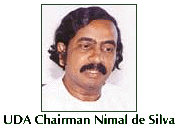 |
 24th January 1999 |
Front Page| |
Houses of all housesBy Hiranthi Fernando
Mumtaz Mahal, the stately old building located in Kollupitiya, dating back over a century, has served as the official residence of the Speaker for many years. "Mumtaz Mahal is a superb building," Urban Development Authority (UDA) Chairman Nimal de Silva said. "It has excellent spaces and architectural forms. However, it has been condemned since it is in a bad state. The roof timber needs to be replaced as well as the Calicut tiles, which have a life span of a hundred years. Some of the walls are also said to be crumbling with the effect of the sea air," he said. Repairs to Mumtaz Mahal are expected to cost over Rs. 60 million. Further, the annual cost of maintenance is also high. "The engineering profession has a tendency to condemn old buildings which need extensive repairs," Prof. de Silva, who is an architect by profession said. However, he stressed it is a national monument and will be preserved. "A city without old buildings is like a man without memory. We can never construct buildings of that nature today," he said. Since Mumtaz Mahal belongs to Parliament, a decision has to be taken by it as to what its future use would be. Requests have been received from many quarters to take it on lease since it is a prestigious building. The state of disrepair Mumtaz Mahal is in and its distance from the Parliament contributed to the decision taken in 1996, to build a new complex for the Speaker, within easy reach of the Parliament complex. A six acre tract of marshy land on Sri Jayawardenapura Mawatha was thus selected. The building area covering 2.5 acres, has been filled up. According to land reclamation clearance, a retention pond covering the balance land forms a moat around the complex. Access is provided by a main driveway and a service entrance on the side. Piling work on the site is due to start in a few days. The project is being handled by a UDA team headed by Athula Dissanayake. The UDA and the State Engineering Corporation (SEC) are the Consultants for the project. By means of a scale model of the complex, Ms. Renuka Wickremasinghe, Deputy Director, Design and Project Management Division of the UDA, explained the layout of the complex. It will be made up of seven blocks occupying 2,300 sq.metres of space. Three of the blocks have two stories while the other four are single storeyed. The driveway leads to the entrance porch, which is the first block. The largest of the two storey buildings is the office block, which includes an auditorium. The second is the Speaker's residence block and the third, a visitors' block with bedrooms and living area. The other three blocks are set aside for the caretaker's residence, security quarters and kitchen staff quarters. According to Prof. de Silva, the cost of the project inclusive of land, filling, construction, sewerage and water connections, is estimated at Rs. 147 million. Bids will be called for the construction. The construction of the buildings will start in May, after the piling work is finished. The Speaker is keen to complete the work before the end of his term. "We are trying to keep to schedule and hope to finish by May 2000," Prof. de Silva said. Prof. de Silva said the buildings had been restricted to two floors so that the dominant character of the Parliament building situated further up the road is not diminished. The area around the buildings will be extensively landscaped. The landscaping is being undertaken by the UDA. It has been decided to use local trees that can grow in marsh land, such as Kumbuk, Bakmee, Mal Murutha and other suitable varieties. "We are looking for form, colour and flowering varieties," Prof. de Silva remarked. "With the moat surrounding the complex, it will be beautiful. We want to get its reflection on the water in the moat. The moat which was a necessity for water retention since the marsh land was filled has been converted as part of the aesthetic achievement. It also has more water carrying capacity now than the marsh land had." |
||
 |
More Plus * It's a full time job
Front Page| News/Comment| Editorial/Opinion| Business| Sports | Mirror Magazine |
|
 |
Please send your comments and suggestions on this web site to |
|
 A
new official residence for the Speaker of the House is scheduled for comple-
tion in year 2000. The foundation stone was laid last month. The site selected
for the proposed new residence is a scenic spot on the Sri Jayawardenapura
Highway, not far from the Parliament complex.
A
new official residence for the Speaker of the House is scheduled for comple-
tion in year 2000. The foundation stone was laid last month. The site selected
for the proposed new residence is a scenic spot on the Sri Jayawardenapura
Highway, not far from the Parliament complex.